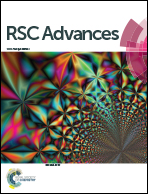Localized surface plasmon resonance of Cu nanoparticles by laser ablation in liquid media
Abstract
Expanding localized surface plasmon resonance (LSPR) towards long wavelengths has been the focus of plasmonics for several decades. Compared with the most studied Au and Ag nanoparticles, Cu nanoparticles have intrinsic long-wavelength LSPR, but hard to be facially fabricated due to their sensitivity to oxidation. Here, we report on the facile and rapid fabrication of colloidal copper nanoparticles by laser ablation in liquid (LAL) operated in ambient conditions, and their LSPR properties. A formation mechanism was put forward to reveal the optical properties of colloidal copper nanoparticles. The effects of different parameters, such as laser power density, ablation time, surfactant concentration, organic solvents and aging time, on LSPR properties were investigated. Eventually, we can decrease the oxidation of colloidal copper nanoparticles by mediating disparate factors, and then tune the position and intensity of copper LSPR peaks. And our results will be beneficial to the application of copper LSPR in optical catalysis, sensitivity, detection devices, and conductive pattern making based on the printing technologies.


 Please wait while we load your content...
Please wait while we load your content...